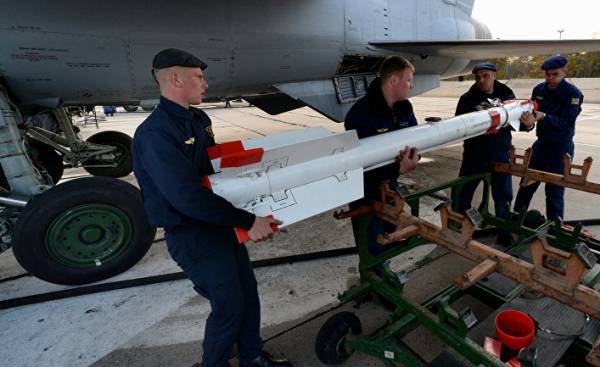
Actually, the problem is not only that the PL-15 is superior to AMRAAM in range, if it is determined onboard J-20. With its help, the Chinese will be able to strike at the tanker aircraft and the aircraft-scouts, which are extremely important in the conduct of air campaigns in the skies over the Pacific ocean. As noted in 2008 at his briefing center at RAND to carry out combat missions of the F-22 with GUAM for operations in the skies over Taiwan, the US air force needs to perform 3-4 of departure of the tankers in the hours to deliver 12 million gallons of fuel. This fact has not escaped the attention of the Chinese.
Of aircraft J-20 very little specific information, but it looks like it was optimized to fly at high speed over long distances, to be unobtrusive and to carry on Board a serious combat load. This plane has a reduced effective surface scattering, it has supersonic speed and armed with missiles PL-15, placed in the inner compartments. It is therefore possible that J-20 have the capacity to threaten tanker aircraft and aircraft-reconnaissance United States air force in the skies over the Pacific ocean. As noted in the RAND study from 2008, the Chinese with their variants of the su-27 almost destroyed all the American tanker aircraft, reconnaissance aircraft, and patrol aircraft and machine control during simulation of rockets “air-air” long range.
The new generation of Russian and Chinese long-range missiles of class “air-air” can pose a threat to critical network nodes control the actions of the United States air force. Among these nodes, the system long-range radar detection and warning AWACS, various aircraft reconnaissance and surveillance, tanker aircraft and aircraft electronic jamming.
Experts do not pay much attention to such weapons to intercept air targets in the analysis of the Russian and Chinese systems, interdiction of access/blocking areas (A2/AD), giving preference to anti-ship missiles and rockets “earth-air”. But when set to the right fighter’s weapons could weaken the U.S. ability to conduct extended air operations into the Asia-Pacific and European theaters of war. The crucial point is that Russian and/or Chinese military can install long-range missiles “air-air” on such aircraft as the MiG-31, T-50 PAK-FA and J-20 for strikes on American cars AWACS, air force aerial reconnaissance and surveillance, and tanker aircraft such as the KC-135 and the coming into service of the KC-46 Pegasus. Clumsy tanker aircraft can be the Achilles ‘ heel of the U.S. air force, especially in the vast Pacific ocean, where few airfields and the distances between them are great. Beijing could take advantage of this weak point. Particularly noteworthy are three programs in the development of missiles “air-air” long-range Russian missile R-37M (RVV-BD), KB “Vympel”, KS-172 (K-100) design Bureau “Innovator” and the Chinese PL-15.
The new Russian aircraft missile long range R-37M (RVV-BD) class “air-air” is already suitable for use on Board aircraft of the MiG-31BM. Over time it will begin to arm the su-35S and stealth aircraft T-50 PAK-FA. There have been recent allegations that the RVV-BD (AA-13 Arrow according to NATO classification) successfully intercepted targets at ranges of over 160 nautical miles (300 km).
“Advanced missile R-37M (RVV-BD, the product is 610M) is in serial production in 2014, and now it is obvious the forces are already receiving, where it is used in squadrons of upgraded MiG-31BM interceptors, — told the researcher, Mikhail Barabanov, working chief editor of Moscow Defense Brief, which is published by the Moscow Center for analysis of strategies and technologies. — Missile RVV-BD is also planned to use the aircraft T-50”.
The initial version of the R-37 was developed in the Soviet Union for attacks on important military tools of NATO aircraft such as the AEW E-3 Sentry, the aircraft command and control and targeting E-8 JSTARS and reconnaissance aircraft RC-135V/W Rivet Joint. The plan consisted of the following: to use high speed fighter type MiG-31 that can reach speeds of M=2,35 at a radius of 390 nautical miles (720 km) and carries considerable combat missile load, for delivery of new missiles to target and destroy these weapons. Such aircraft as the MiG-31 (or supersonic stealth aircraft PAK-FA) is ideal for this task because of the large speed and altitude is hard to intercept.
“R-37 is a specialized missile designed to destroy aircraft reconnaissance, information gathering and surveillance. It was developed and tested in 1990-e years, — said the scientist-researcher Mike Coffman (Mike Kofman), worked at the Center for naval analyses, which specializes in Russian military issues. It was not only for installation on the MiG-31. There was another later version, created by OKB Novator KS-172, which today is often called To-100”.
After the collapse of the Soviet Union in 1991 the Russian military industry has continued work on P-37, but it was slow. 90 years was a very difficult time for the defense industry, as its funding was sharply reduced. In fact, the original R-37 Soviet period were abolished, but later this work was resumed — this time, over the current variant of the RVV-BD. “Development of sample R-37 (item 610) was stopped in 1997,” said Drums.
In the R-37M likely use inertial guidance with radio of course, which carries the plane-submarine and the final trajectory of the flight involved active radar homing. During the fighting, the aircraft type MiG-31 is directed to the target at high speed and produce salvo launch missiles R-37M. It is possible that he may follow the purpose, having on Board a powerful radar with a phased antenna array “Zaslon-M”, and transmit data to the missile until, until will not turn on its own radar. The missile can also smonautics the source of the jamming, similar to the American AIM-120D AMRAAM, combat electronic warfare aircraft such as EA-18G Growler the Boeing company.
The Soviet Union knew perfectly well that one of the main benefits of NATO and US lies in their ability to conduct coordinated air campaign with the use of systems such as AWACS. Soviet Union worked a number of methods to counter the AWACS aircraft, including missiles “air-air” long-range passive homing system. “As I understand it, the topic of missiles “air-air” with passive guidance was popular in the Soviet Union in the 1980-ies (see also R-27P), but today it is recognized as unpromising,” said Drums.
RVV-BD is a formidable weapon, But obviously Moscow is developing an even more effective missile KS-172 on the basis of the design Bureau “Innovator”. Sometimes the missile called K-100. It is believed that the maximum range RVV-BD is less than 200 nautical miles (370 km), but this system of OKB “Innovator” capable of hitting targets at a distance of 250 nautical miles (460 km). “More than 200 nautical miles is too cool for R-37M, — said Kofman. — Only “Innovator” makes missiles to engage targets at such a distance. It’s something like KS-172 which was designed to destroy targets at a distance more than 200 nautical miles”.
However, it is unclear when the missile KS-172 / K-100 will be developed and will go into production, and whether this can happen. There is evidence that project K-100 for a long time lay on the shelf, and that he may never see the light of day. “With regard to K-100, they wanted to get money from India to complete the development, — said Kofman. — This is a great missile design Bureau “Innovator”, but I doubt it will ever be brought to a state of operational readiness. This long spear does not need fifth-generation aircraft”.
Drums even claims that the project K-100, most likely, stopped. “Regarding the missile K-100 I have no doubt that this program works, he said. I think this was discontinued for a long time”.
Meanwhile, at the other end of the planet China is developing missiles PL-15 with ramjet engine, which can have a range of slightly less than 200 kilometers. This weapon has caused consternation among the leadership of the U.S. air force and the commander of the air operations General Herbert Carlisle (Herbert Carlisle), nicknamed “the Hawk” was named the new Chinese missile one of the main reasons that made America to begin developing missiles of a new generation to replace the old AIM-120 AMRAAM.
“How do we counter this, and what do we do to counter this threat?” asked Carlisle during a speech last year at the Center for strategic and international studies. Later giving an interview with Flightglobal, Carlisle noted that opposition to the new Chinese missile was “an extremely important priority for the U.S. air force. “Looking at the PL-15 and its range, we know we need to beat this rocket”, — said the General.
Actually, the problem is not only that the PL-15 is superior to AMRAAM in range, if it is determined onboard J-20. With its help, the Chinese will be able to strike at the tanker aircraft and the aircraft-scouts, which are extremely important in the conduct of air campaigns in the skies over the Pacific ocean. As noted in 2008 at his briefing center at RAND to carry out sorties from GUAM for operations in the skies over Taiwan, the US air force needs to perform 3-4 of departure of the tankers in the hours to deliver 12 million gallons of fuel. This fact has not escaped the attention of the Chinese.
Of aircraft J-20 very little specific information, but it looks like it was optimized to fly at high speed over long distances, to be unobtrusive and to carry on Board a serious combat load. This plane has a reduced effective surface scattering, it has supersonic speed and armed with missiles PL-15, placed in the inner compartments. It is therefore possible that J-20 have the capacity to threaten tanker aircraft and aircraft-reconnaissance United States air force in the skies over the Pacific ocean. As noted in the RAND study from 2008, the Chinese with their variants of the su-27 almost destroyed all the American tanker aircraft, reconnaissance aircraft, and patrol aircraft and machine control during simulation of rockets “air-air” long range.
U.S. air force considering the dispersal of its air bases and on the development of a logical and sustainable system of logistics these austere airfields to counter the Chinese forces and means of preventing access/blocking zones in the Pacific theater. But the air force have not yet fully developed a plan for protection against enemy air attack its refueling, reconnaissance and patrol aircraft, as well as management tools. In the air force, there is only one answer to this problem: to transfer aircraft to a safe distance beyond the range of Chinese air forces and means. But in this case, the reduced effective range tactical fighters of the U.S. air force, and they will lose the opportunity to strike deep in Chinese territory.
Thus, on the basis of available information it can be concluded that the efforts of Russia and China’s missile of class “air-air” long-range missiles and fifth generation fighter aircraft for delivery to the target can create significant problems for the Pentagon. And these problems should be closely monitored in the coming years.
Dave Majumdar is editor of the National Interest, covering military issues.







